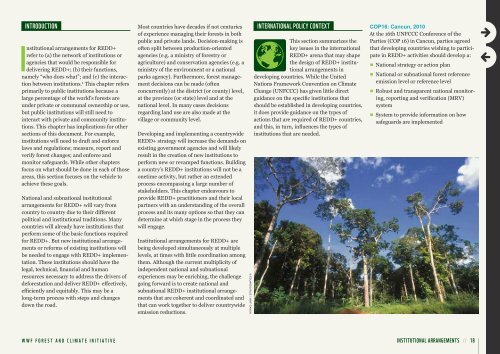WWF Guide to Building REDD+ Strategies
WWF Guide to Building REDD+ Strategies
WWF Guide to Building REDD+ Strategies
You also want an ePaper? Increase the reach of your titles
YUMPU automatically turns print PDFs into web optimized ePapers that Google loves.
intRoduCtion<br />
institutional arrangements for <strong>REDD+</strong><br />
refer <strong>to</strong> (a) the network of institutions or<br />
agencies that would be responsible for<br />
delivering <strong>REDD+</strong>; (b) their functions,<br />
namely “who does what”; and (c) the interaction<br />
between institutions. 1 This chapter refers<br />
primarily <strong>to</strong> public institutions because a<br />
large percentage of the world’s forests are<br />
under private or communal ownership or use,<br />
but public institutions will still need <strong>to</strong><br />
interact with private and community institutions.<br />
This chapter has implications for other<br />
sections of this document. For example,<br />
institutions will need <strong>to</strong> draft and enforce<br />
laws and regulations; measure, report and<br />
verify forest changes; and enforce and<br />
moni<strong>to</strong>r safeguards. While other chapters<br />
focus on what should be done in each of those<br />
areas, this section focuses on the vehicle <strong>to</strong><br />
achieve these goals.<br />
National and subnational institutional<br />
arrangements for <strong>REDD+</strong> will vary from<br />
country <strong>to</strong> country due <strong>to</strong> their different<br />
political and institutional traditions. Many<br />
countries will already have institutions that<br />
perform some of the basic functions required<br />
for <strong>REDD+</strong>. But new institutional arrangements<br />
or reforms of existing institutions will<br />
be needed <strong>to</strong> engage with <strong>REDD+</strong> implementation.<br />
These institutions should have the<br />
legal, technical, financial and human<br />
resources necessary <strong>to</strong> address the drivers of<br />
deforestation and deliver <strong>REDD+</strong> effectively,<br />
efficiently and equitably. This may be a<br />
long-term process with steps and changes<br />
down the road.<br />
Most countries have decades if not centuries<br />
of experience managing their forests in both<br />
public and private lands. Decision-making is<br />
often split between production-oriented<br />
agencies (e.g. a ministry of forestry or<br />
agriculture) and conservation agencies (e.g. a<br />
ministry of the environment or a national<br />
parks agency). Furthermore, forest management<br />
decisions can be made (often<br />
concurrently) at the district (or county) level,<br />
at the province (or state) level and at the<br />
national level. In many cases decisions<br />
regarding land use are also made at the<br />
village or community level.<br />
Developing and implementing a countrywide<br />
<strong>REDD+</strong> strategy will increase the demands on<br />
existing government agencies and will likely<br />
result in the creation of new institutions <strong>to</strong><br />
perform new or revamped functions. <strong>Building</strong><br />
a country’s <strong>REDD+</strong> institutions will not be a<br />
onetime activity, but rather an extended<br />
process encompassing a large number of<br />
stakeholders. This chapter endeavours <strong>to</strong><br />
provide <strong>REDD+</strong> practitioners and their local<br />
partners with an understanding of the overall<br />
process and its many options so that they can<br />
determine at which stage in the process they<br />
will engage.<br />
Institutional arrangements for <strong>REDD+</strong> are<br />
being developed simultaneously at multiple<br />
levels, at times with little coordination among<br />
them. Although the current multiplicity of<br />
independent national and subnational<br />
experiences may be enriching, the challenge<br />
going forward is <strong>to</strong> create national and<br />
subnational <strong>REDD+</strong> institutional arrangements<br />
that are coherent and coordinated and<br />
that can work <strong>to</strong>gether <strong>to</strong> deliver countrywide<br />
emission reductions.<br />
© EDUARDO RUIZ / <strong>WWF</strong>-CANON<br />
inteRnational PoliCy Context<br />
This section summarizes the<br />
key issues in the international<br />
<strong>REDD+</strong> arena that may shape<br />
the design of <strong>REDD+</strong> institutional<br />
arrangements in<br />
developing countries. While the United<br />
Nations Framework Convention on Climate<br />
Change (UNFCCC) has given little direct<br />
guidance on the specific institutions that<br />
should be established in developing countries,<br />
it does provide guidance on the types of<br />
actions that are required of <strong>REDD+</strong> countries,<br />
and this, in turn, influences the types of<br />
institutions that are needed.<br />
COP16: Cancun, 2010<br />
At the 16th UNFCCC Conference of the<br />
Parties (COP 16) in Cancun, parties agreed<br />
that developing countries wishing <strong>to</strong> participate<br />
in <strong>REDD+</strong> activities should develop a:<br />
n National strategy or action plan<br />
n National or subnational forest reference<br />
emission level or reference level<br />
n Robust and transparent national moni<strong>to</strong>ring,<br />
reporting and verification (MRV)<br />
system<br />
n System <strong>to</strong> provide information on how<br />
safeguards are implemented<br />
<strong>WWF</strong> FOREST AND CLIMATE INITIATIVE inStitutional aRRanGementS // 18

















